Yesterday we hosted one of our most popularly registered webinars to date. The focus was “How to use perks to increase employee retention”. The co-founder of Compt, Sarah Bedrick, joined Lola at their office to talk about the importance of perks, how they are changing, and how to use them to increase employee retention.
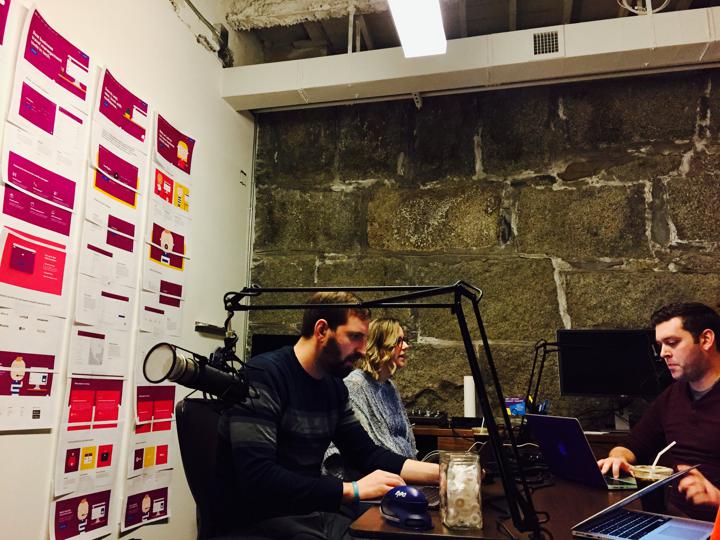
If you couldn’t make it, below are the most important things you need to know. Alternatively, you can watch the webinar in full here.
First, what are employee perks?
Perks are ways to support the employees in addition to salary or benefits and include purchasable, programmatic, and environmental perks.
- Purchasable perks include catered lunches, books, fitness stipends, pet insurance and student loan forgiveness.
- Programmatic perks are policy-driven advantages to working at a company such as remote work opportunities, being pet-friendly, or offering Summer Fridays.
- Environmental perks are the ways in which you set up your office including meditation rooms, slides, and the overall space.
Having a common definition of “perks” is critical to being able to discuss them, their goals, benefits, and how organizations can best use them to attract, engage, and retain employees today.
How have perks evolved?
Perks, when they first emerged over a decade ago, were considered “nice-to-haves” and employees’ expectations for them were low. Companies offered things that we today consider “fluffy” like snacks, free beer, ping pong, and massages. Also, because perks were considered a bonus by employees, there weren’t any formal processes or programs around them. There was often free beer in the fridge and snacks lying around, but it wasn’t a big deal when there weren’t.
However, fast forward to today. Perks have transitioned into a “must-have” for every company as expectations are higher than ever. Employees are looking further than free snacks, and demanding more meaningful perks, such as flexibility, wellness, student loan forgiveness, childcare, and continuous education. Perks are now a critical talent strategy that is becoming increasingly expensive.
What are the main problems with perks?
Employee perks are becoming a critical talent strategy for most competitive organizations. Because today’s unemployment rate is so low, the skills gap so large, and the cost of employee turnover so high -- organizations are doing anything and everything they can to attract, engage, and retain talent. That means increasing their perk offerings as a way to make employees happy.
However, as the number of perks continues to increase in an organization, as do the problems they create.

Looking at perks and how they’re missing the mark, or falling short of their goals, is pretty shocking.
Some of the problems of perks today include being able to solve for remote employees. When all of the perks are in the local HQ, remote employees and satellite offices miss out. This is especially concerning when the trend is for more employees to work remote, either fully or partially. The numbers are already pretty high there too, According to Gallup’s State of the American Workplace report, 43% of Americans said they spent at least some time working remotely last year, up from 39% in 2012.
Next, the way in which perks are purchased doesn’t solve for the diversity of staff – for example the five generations at work, student loan forgiveness might be attractive for Millennials but they likely do not solve for Baby Boomers, Generation X, or Generation Y. Because perks are often hand-selected by the organization – they unfortunately end up being generic in nature. Meaning, they’re often not what people would purchase given the money or funds themselves.
They’re also time-consuming for HR to manage. The process of purchasing perks also hasn’t evolved since they first emerged, and so HR team members are no picking, piloting, purchasing, managing, and maintaining a bunch of individual perks and vendor relationships themselves. Without software to help them manage, pay taxes, or see the ROI of the company’s investment.
Perks end up being reactive offerings that companies offer as part of a feedback survey or anecdotal suggestions versus aligning with the company’s very purposeful culture.
What can we do to solve the problems with perks and use them to better retain our employees again?
Evolve our approach.
There are 3 strategies that you can implement in your organization to attract, engage, and most importantly, retain employees:
- Thinks perks program, instead of just perks
- Introduce flexibility-focused perks
- Personalize perks
We briefly describe each one of these strategies in the following section:
1. Think perks program, instead of just perks.
When a company offers perks, most often they’re thought of as individual perks a company offers. There are a couple of reasons for this – first, there are tons of perks out there in the world – a great big, intimidating perk ecosystem if you will.
The perks ecosystem looks something like this:
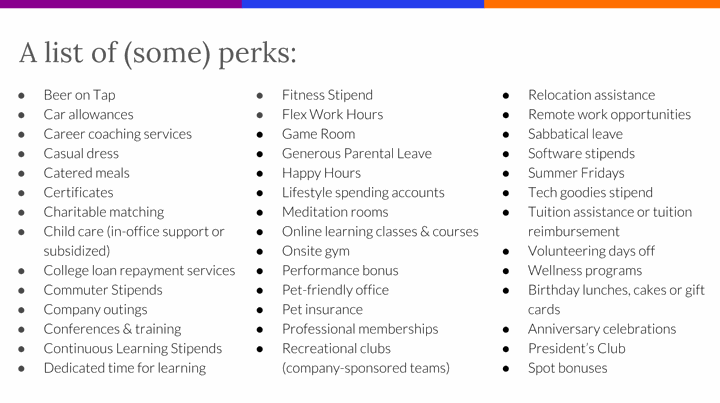
And it’s tempting to pick a few perks here and there that your company needs based on your budget, and then expand each year.
On top of that, companies like Glassdoor that host company reviews and information for employers don’t bring you strategic guidance on how perks could best be communicated to users. Their “benefits” sections of company profiles are often long lists as well:
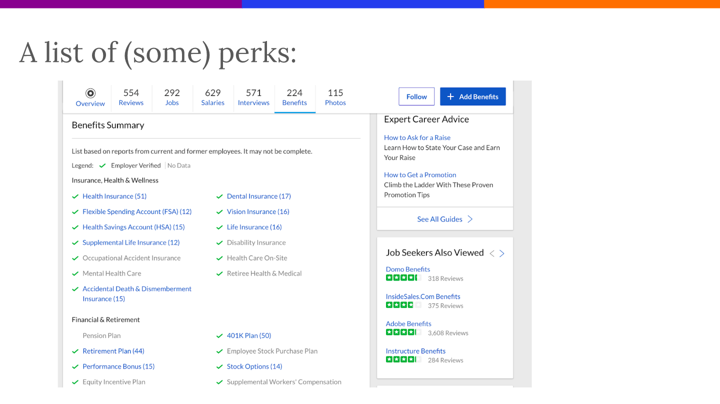
The way that we have been taught to think about perks are single, hand-picked entities that can make your company more attractive in the eyes of candidates.
Thinking about perks this way is hurting your organization as you don’t develop a holistic lens through which you view, build, and communicate your perks as they add value to the organization and employees' lives.
That’s why we’ve developed the “4C & 1P” Perk Framework.
The 4 C’s and 1P represent the 5 types of perks your company could offer. Basically, every perk that exists fits into one of these categories, and it’s a unique way of thinking about your program as a whole, as well as the balance. (Note: if one perk falls into more than one category–such as working remotely could be both a Convenience and Personal perk–you have a gem!).
Below are the 4Cs & 1P, plus the benefits of using this framework:
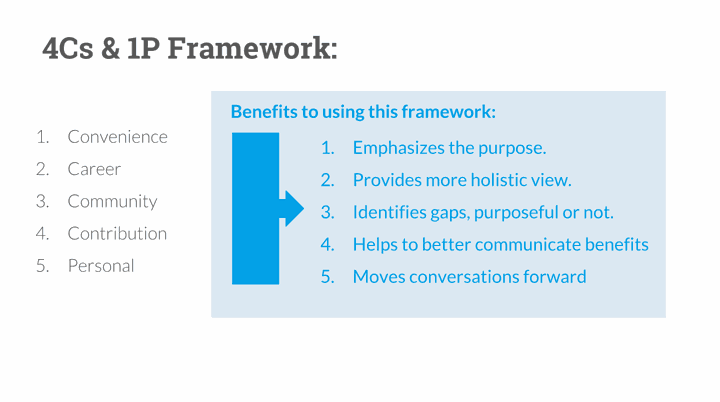
Additionally, here are some short descriptions of each perk category, along with some examples:
- Convenience: a perk that helps employees lives become easier; examples include food, snacks, drinks, and on-site services like dry cleaning, optometry, manicures, etc.
- Career: a perk that helps employees’ skills and careers grow; examples include books, online courses, career coaching, tuition reimbursement, etc. If you're interested in reading more about how much of an ROI investing in your employees careers can be, check out Ace-Up's blog on How Talent Development Directly Increases Your Bottom Line.
- Community: a perk that helps employees connect and have a greater sense of belonging; examples include game nights, company-sponsored teams, or clubs.
- Contribution: a perk that helps employees give back to others; examples include charity events, volunteer days, and company matching on charitable donations.
- Personal: a perk that helps employees' lives become better; examples include gyms, contracts, student loan repayment, travel stipend, pet insurance, daycare subsidy, elder care support.
As a company with strong culture and diversity of employees, it is essential that you build a perks program that has perks of all 5 types to better support the needs of your employees. However, how much of each perk you offer, or do not offer, is up to you and your company’s discretion. By being able to see where most of your perks lie, you’re able to see your gaps and identify the next steps whether it’s to address them or not.
So, here is a more strategic way to think about this framework. It’s the information laid out differently so that you’re able to do an audit of your perks program:
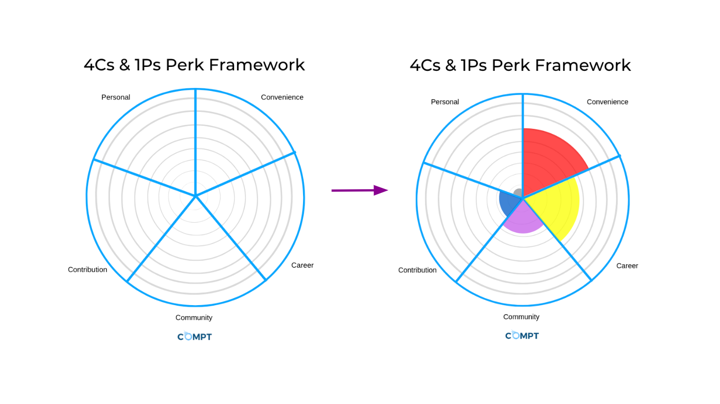
The circle on the left represents the “4Cs &1Ps” Perk framework that you can use to audit your perks program. Each of the segments or “pie-slices” represents a different perk category.
To audit your program, go through each and every single perk your company offers. Find the category which suits it most, and then shade in a line for each perk in that section. Do that for every perk until you're completed and have accounted for every perk in the audit.
For instance, if your company offers six Convenience perks (such as snacks, manicures, and dry cleaning), then you would shade-in 6 lines of the pie-slice in the “Convenience” segment. But if your company only offers one Personal perk (such as pet insurance) then you would only shade-in one line.
When completed, you can see how balanced is your company’s perk program. In our example, the audited company puts a lot of its resources on Convenience perks, and that might be a purposeful approach or it might not. From this state, the company can determine what they should do next based on their goals of perks and their company’s values.
Using this framework helps HR professionals become more strategic in their thinking about their perks program in its entirety, as well as how they will develop and communicate it moving forward.
Download the 4Cs & 1P Perk Framework to complete your audit.
2. Introduce flexibility-focused perks
What is “workplace flexibility” and why does it matter?
“Workplace flexibility” is a way to define how and when work is done.
A concept that recognizes that there are alternatives to the traditional ideas of where and when work is performed. It is a broad term that can include telecommuting, flexible work arrangements, job sharing, and compressed or reduced schedules, among other arrangements. Workplace flexibility helps employees address their work and life needs.
According to a 2018 Werk survey, workplace flexibility impacts companies in the following ways:
- Retention: employees without access to flexibility are 2X as likely to report being dissatisfied at work, and half of employees say they would leave their company if offered a more flexible alternative.
- Advocacy: employees with access to flexibility have employee net promoter scores (eNPS) 48 points higher than those without access to flexibility.
- Engagement and diversity: employees with flexibility are 22% more likely to feel their ideas are valued and 21% more likely to believe they work in an environment that fosters diverse points of view.
What are ideas for flexibility?
Companies can introduce workplace flexibility in a variety of ways, and can harvest the benefits of better connecting with employees, managers, influencers, and decision-makers to roll out an ideal flexibility program.
Identify one area where you can improve your workplace flexibility by reading the following examples and think about how they currently fit, or could fit, your company:
- Remote work
- Partially remote work
- TimeShift: enabling employees to shift their hours to be their most productive self. Example: instead of being in the office from 9-5, allow them to change their hours earlier to 7-3 or 11 to 7 to avoid rush-hour traffic, better accommodate their partner’s schedule, or align with the time where they produce their best work.
- Micro-agility: empowering employees to change their work hours slightly when necessary and make up the hours later, as to not have to take a limited vacation or sick time. Example: giving employees the freedom to step away from the keyboard to run an errand, attend a doctor’s appointment, or pick up a sick child from school, and then make up that missed time later that evening or another day that week.
- Part-time work: letting people temporarily or permanently go part-time to better accommodate a new life situation such as being a parent, caring for their parents, or even wanting to continue their side businesses.
Read more about the different types of flexibility perks via our blog, Top Perks of 2023.
3. Personalize your perks program
What are personalized perks and why do they matter?
Personalized perks are 100% customized to the unique needs, preferences, lifestages, dietary restrictions, locations of employees, and everything else which indicates preference.
According to a MetLife survey, 73% of employees said having benefits customized to meet their needs would increase loyalty to their employees.
And for organizations, Deloitte found that 77% of companies surveyed said that “new rewards” was one of the top 10 global HR trends, but only 37% of companies felt they were “very ready” or “ready” to meet expectations.
These shocking statistics are screaming one harsh reality: we are wasting resources by giving employees perks that they do not need.
How to create a personalized perks program?
It doesn’t have to be difficult to do. And if you’re a little bit innovative, you’re able to get a competitive advantage and join the few percentage that feel they’re very effective at personalized perks. So what’s the secret? How does a company personalize their employee perks?
By using a concept called Lifestyle Spending Accounts (LSA).
A lifestyle spending account is a lot like a perk stipend, and is an employer-created and contributed account for employees. They put the perk money in the hands of employees, so they can get the perks they want and need most.
In the example below, Sam's company has allocated $100 per month for her and other employees to spend in the following categories: learning, health & wellness, and food:
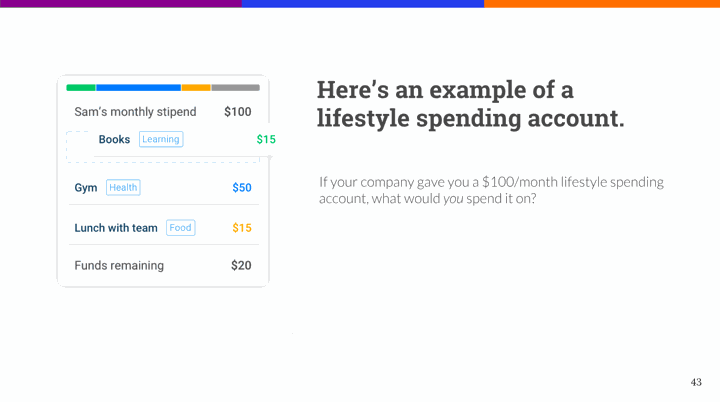
This month, Sam purchased books, a gym membership, paid for a lunch with her team, and still has $20 remaining. Using a lifestyle spending account (LSA), Sam is able to purchase the perks that are most meaningful to her life.
Sam now knows that her company encourages her to learn continuously, follow a healthy lifestyle, and nurture meaningful connections, which can have a tremendous impact in her loyalty, engagement, and satisfaction towards her current workplace.
Lifestyle spending accounts are an innovation on the purchasing and delivery model of perks.
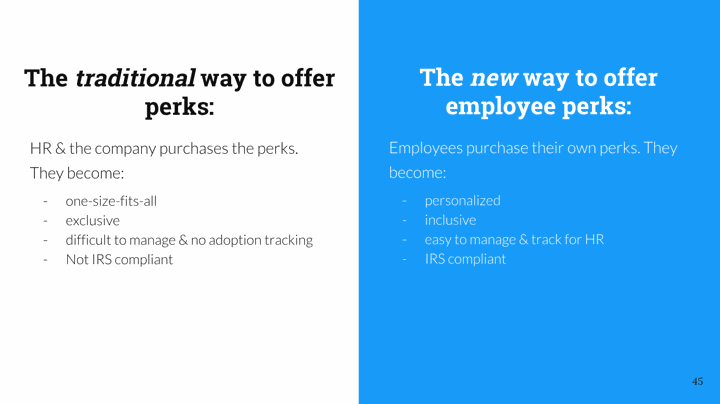
How do lifestyle spending accounts, the “new way” to offer employee perks, vary from the traditional approach? They’re an innovation on the purchasing process for HR, as well as the delivery model for employees.
When companies use lifestyle spending accounts, they experience the following benefits:
- Perks become personalized: Spotify, Airbnb, and social media feeds deliver a personalized experience. Lifestyle spending accounts does the same for perks. The needs of a single employee living in the city are different from a married employee with three children in the suburbs. Compt allows HR to provide benefits where their employee needs are.
- Perks become inclusive: when employees are selecting their own perks, people no longer feel excluded. For instance, if a company has a fully-stocked coffee bar, the tea drinkers no longer feel excluded because the company doesn't offer teas.
- Perks become easier to administer and track: with the responsibility of choosing perks on the employee, HR no longer needs to pick, pilot, purchase, manage and maintain all of the individual perks and vendor relationships. Additionally, using a software to administer your lifestyle spending accounts often provides utilization reports so you can see the ROI.
- Perks become tax compliant: Tax compliance becomes easier and CFOs and finance teams can rest easy knowing that all the data is there in case they are audited by the IRS.
Download the comprehensive Lifestyle Spending Account eBook.
BONUS: Combine personalized perks with the Wheel of Life exercise
What is the Wheel of Life?
Here is a video explaining how you can combine the wildly successful Wheel of Life exercise with personalized employee perks to 10x your employee experience:
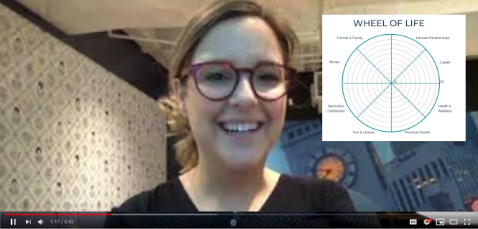
By combining the Wheel of Life along with an open-mind to welcome innovation, you can create a perks program that better fits your company, your employees’ needs, and a strong company culture that will help you attract, engage, and retain top talent.
Download the Wheel of Life template.
Webinar Q&A:
There were several questions at the end of the webinar, below we've highlighted them and included the answers as well.
What are ways to source the perks employees want?
While it’s not explicitly stated as part of their job function, HR often finds themselves in a position akin to a concierge or library catalog needing to know the different products or services available to help employees. To make this job easier, we developed a list of perks and potential perk vendors HR could use or reference when developing a “perkstack” for employees.
How can a company check in on employee satisfaction with perks program?
There are a few ways which include:
- Sending out an eNPS survey. This can give you an overview of your employees overall satisfaction, and some answers might highlight what employees need in relation to perks.
- Creating a perk-specific survey. This would be a survey dedicated to asking people their thoughts on your existing perk program.
- Holding office-hours, asking in Slack, or informal ways to get anecdotal feedback but keep in mind it might not be a full representation of what your team’s general sense is.
Negatives of timeshift and working remote? How can you still create a sense of community? What are ways to balance it?
Of course there are negatives to timeshifting, but what’s important is to ask is do they outweigh the benefits an organization would receive from this transition. And in relation to creating a sense of community, there is a lot a company can do. Some ideas include: encouraging employees to create groups around similar interests (hiking, running, board games), create ways for employees connect like book clubs, host retreat weeks, volunteer together like Movember November, update office spaces for group meditation or group innovation, implement tools that allow collaboration and fun, Hangouts, Pair Buddies, in-person meetups, randomized “meetup” generators for people to connect in person or virtually. These team activities can help create a better sense of community that your employees will benefit from.
In the “4cs & 1p” perk framework, are all the 5 different types of perks equally important? Does it differ from company to company?
It certainly does differ from company to company, what people want also differs from employee to employee. While Adam Grant, author of Give and Take and Organizational Behavior professor, might argue that career, community, and contribution are the most important to employees, what is most important depends on the person and their need in the moment.
Now that you've read more about perks, it's time to learn about the TOP Employee Perks For 2019! Read all about them and implement them in your organization to see big results.
Compt is the #1 employee stipends platform that gives your people the freedom to choose the lifestyle perks that are best for them and their always evolving needs, even when remote. Interested in learning how Compt might benefit your company? Consult with our team or request a demo.
